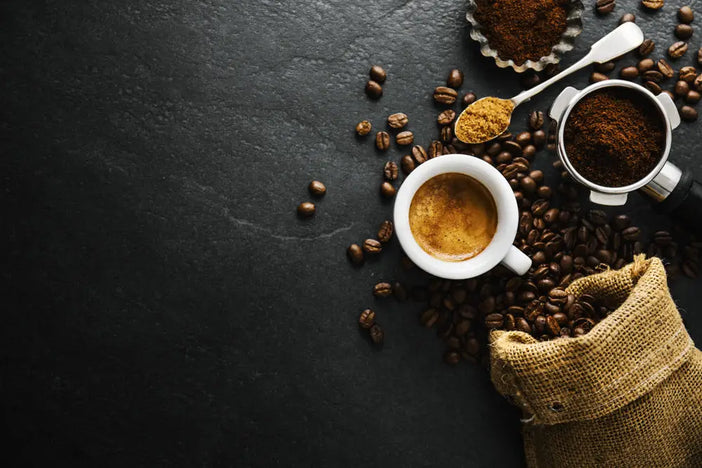National Espresso Day: espresso is good news for type 2’s


Coffee or Espresso? What is the difference between the two and is it good for us? On National Espresso Day we wanted to get to the bottom of these questions and take a look at how espresso is considered a healthy part of a balanced lifestyle with type 2.
Espresso is the bold-flavored, slightly-thicker-than-coffee drink that comes from finely-ground beans brewed with a high grounds-to-water ratio. Coffee, on the other hand, is a thinner, less concentrated liquid that generally has a milder flavor and the grounds used are coarser. The brewing method is a big difference, with an espresso the almost boiling water is shot through a pressurized espresso machine whereas gravity is used to brew coffee. The beans are typically the same. Therefore all espresso is made from coffee but not all coffee is espresso.
Is there a difference in nutrition between coffee and espresso?
A single shot of espresso contains 0g total carbs, 0g net carbs, 0g fat, 0g protein, and 5 calories. However, espresso has more Vitamin B3, Magnesium, Vitamin B2, and Copper than Coffee. All coffee contains polyphenols, which are a molecule that have antioxidant properties which are widely believed to help prevent inflammatory illnesses, such as type 2 diabetes, and anticarcinogenic (anti-cancer) properties.For a more in depth breakdown of the nutritional value of espresso vs. coffee you can visit this link here.
Benefits and Risks of Daily Consumption
First of all, there are many differing opinions and findings about the studies that have been done on espresso consumption. Sometimes there is even conflicting information. Something everyone seems to agree on is that drinking coffee (espresso) moderately is safe for people with type 2’s - especially when consumed without extra sugars and fats added.
Coffee makes us feel alert, awake and even more motivated. The caffeine in espresso finds its way to our brain receptors and immediately gets to work, giving neurons an alertness bumping boost. A moderate amount of caffeine is considered approximately 300 milligrams, or the equivalent of 4.5 ounces of espresso. Having 1-4 ounces (shots) of espresso each day can be considered healthy.
“There aren’t a lot of downsides to drinking moderate amounts of coffee — and in fact, it can have positive effects on your health,” says registered dietitian Andrea Dunn, RD.
However, it’s true, you can have too much of a good thing. The key is moderation. Drinking too much coffee can give us some undesirable side effects such as:
- Increased heart rate
- Raised blood pressure
- Anxiety
- Trouble falling asleep
Caffeine in high doses raises your blood level of epinephrine. Epinephrine is also known as adrenaline. In pure forms, epinephrine can increase blood pressure, increase the contractility or force of the heart, and mildly increase the heart rate. This can in turn make you feel anxious.
It can take approximately six hours for half of the caffeine you consume to leave your system. Therefore, if you decide to indulge in a late afternoon shot of espresso you might suffer the consequences of restlessness and insomnia. It is better to enjoy your espresso in the morning and early afternoon to avoid any issues with sleeping.
As for the benefits of drinking coffee, Diabetes UK writes that coffee has been shown to lower risks of the following conditions:
- Type 2 diabetes
- Cancer – such as endometrial cancer and aggressive prostate cancer
- Cardiovascular disease
- Strokes
- Alzheimer’s disease
- Parkinson’s disease
Health lines cited a study that notes “drinking coffee over a long period may also change its effect on glucose and insulin sensitivity.” In other words, being a regular coffee drinker over an extended period “maybe what causes the protective effect.”
National Espresso Day Recipe
Ice Pumpkin Spice Latte
Blend all ingredients to create a seasonally-inspired drink. Using real pumpkin adds beneficial fiber.
- 2 shots espresso
- ½ cup milk of your choice (such as unsweetened vanilla flavored almond milk, skim or 1% milk)
- 2 teaspoons pumpkin pie spice (or ½ teaspoon each ground cinnamon, nutmeg, ginger and allspice)
- 1 teaspoon vanilla extract
- ½ cup canned plain pumpkin
- 4 ice cubes
Limit added sugar as much as you can! If you MUST add sweetener, try pure maple syrup in a small quantity- start with 1 teaspoon.
Conclusion
When you order a coffee at a coffee shop, see what diabetes friendly, sugar-free sweetener options are available. You can also inquire about what types of milk or non-dairy milk options are available. Remember that caffeine affects every person differently. For people with type 2, or you're struggling to control your blood sugar levels, limiting the amount of caffeine in your diet may provide a benefit.
Enjoy National Espresso Day and continue to stay informed on great ways to manage Type 2 - Join the Winning Type 2 Diabetes Together community on Facebook and connect with thousands of other diabetics around the world.




